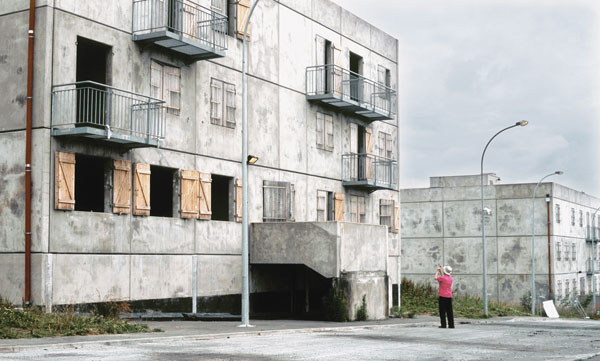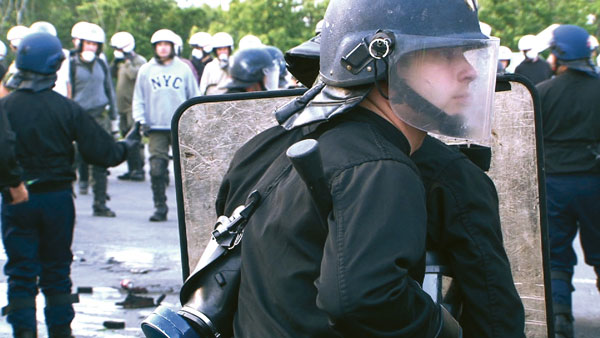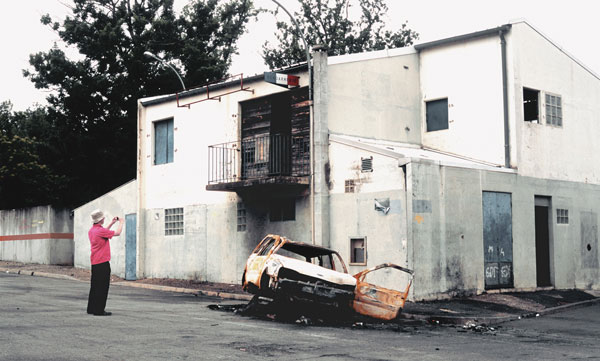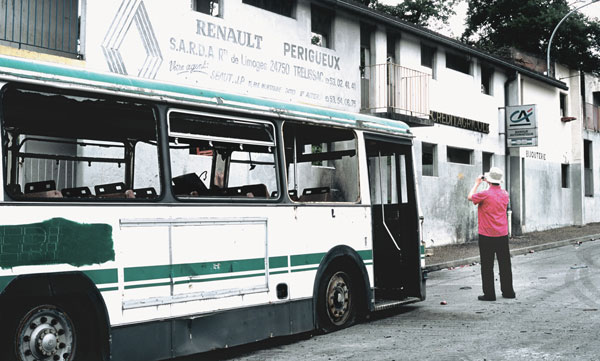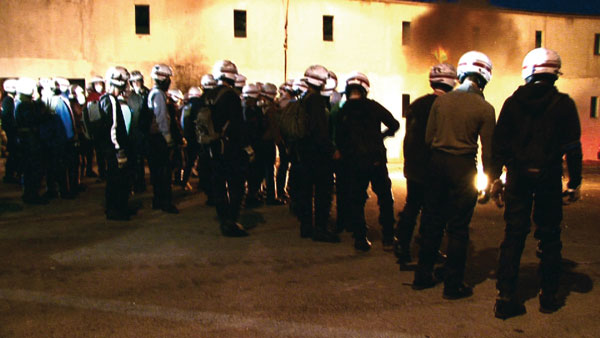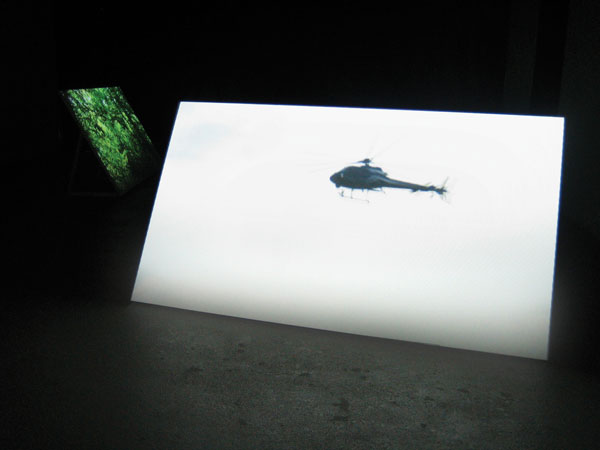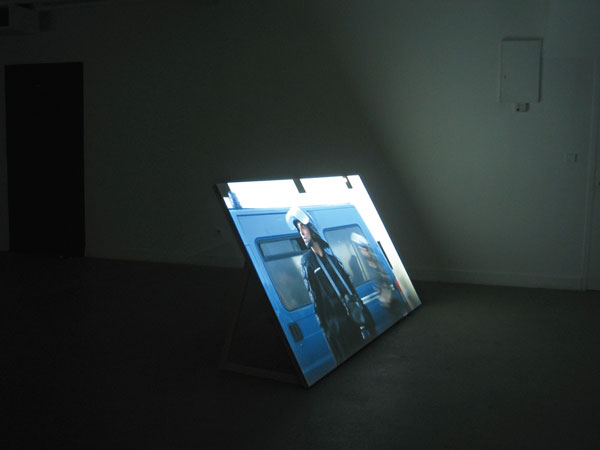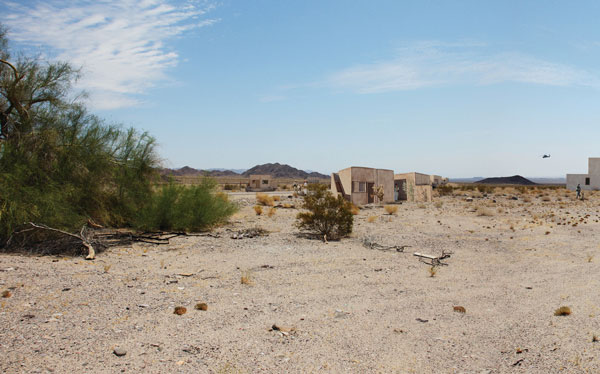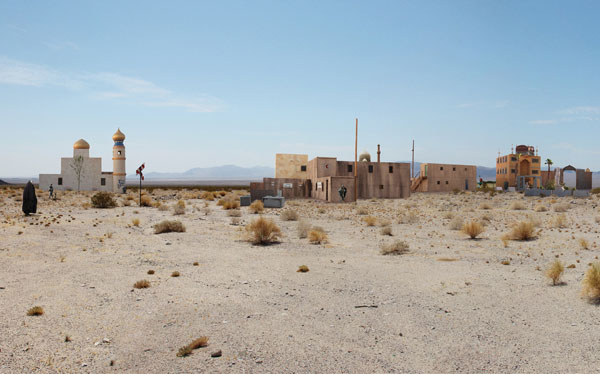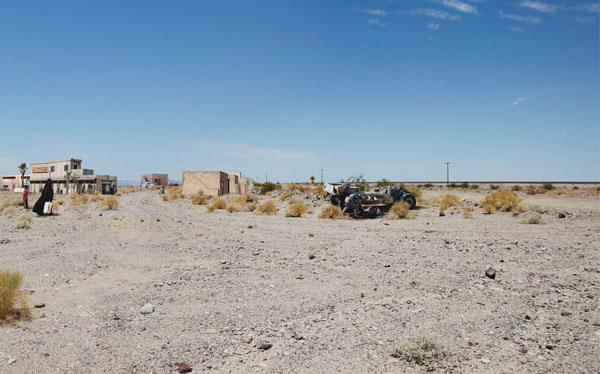[Summer 2010]
Now just have a look at this machine. Up till now a few things still had to be set by hand, but from this moment it works all by itself … . It’s a remarkable piece of apparatus …
– Franz Kafka, The Penal Colony 1
Recent years have seen an interpenetration of mass media (as both publicity and technics), state violence, and “terrorism.” Simultaneously, the intrusion of administration and management into all aspects of everyday life has become ever more insidious. In the epoch of “biopolitics,” in which life is defined in terms such as “breeding,” “adaptation,” and “being-in-formation,” neither politics nor ethics can be understood solely in terms of individual rights or economic systems. Kafka’s description of a torture machine as a self-regulating disciplinary device, a dispositif, or an “apparatus” applies well to “media” in this epoch. Kafka’s device, “working all by itself,” expresses our current situation – the protection of life becoming the administration of death.
The exploration by Emanuel Licha, a Paris-based artist, of the media’s role in this administration reveals an ambiguity: media dissimulation supports the legitimacy of the state monopoly on violence, but it also appears in challenges to state–corporate collusion in the regulation of visual modes of participation in warfare. Licha’s project defines itself as such a challenge to the forces of domination and regulation of the visual field, and, most perceptively, reveals a situation in which the primary dissimulation is one in which concealment occurs by showing. This state–corporate regulatory project is embodied in spatial techniques adopted from architecture and cinema. The virtualization of architecture has followed the recognition of film as already architectural. The integration of computer-assisted design and production in this field is a contributor to the high-stakes competition over who or what controls the definition of perception, the public space, and what will be called “reality” – and, perhaps more importantly, who or what defines the matter as an issue of “control.”
In War Tourist (2004–2008), R for Real (2008), Bagdads (2009), and Mirages (2010) Licha uses architectural and theatrical means to situate the viewer with respect to photography and mass media – that is, he constructs a participatory relationship with the viewer using the device of mise-en-scène arranged using the dissimulation procedures common to architecture, cinema, the art institution, and, now, the military. His concern is to open gaps to engage critical subjectivity in the network of spectacle and permanent global war, and his approach involves staged empiricism and fictional documentary. In his “set-ups,” he empirically documents “actual” events and sites constructed for the training of police and military recruits in simulated combat situations, with an emphasis on the media dimension of contemporary combat and social control. For Mirages and Bagdads, Licha filmed and photographed at Fort Irwin, a vast U.S. training facility in the California desert built, with Hollywood expertise, to resemble an Iraqi city, complete with Iraqi immigrants to the United States acting the roles of Iraqi civilians and insurgents. Licha also photographed at a major Hollywood studio and at sites of various exotic simulations in Las Vegas, and these elements overlap in his constructions.
What is most remarkable in Licha’s practice is his proposal that we examine the current affinity between “media” (roughly, the realm of an aestheticized politics) and military force. Resulting from a confrontation between the photographic and televisual image as it functions in both current practices of state violence and struggles to challenge the legitimacy of such violence, his gallery installations propose mise-en-scène and performativity as a passage to critical agency.
The five-channel video installation War Tourist specifically confronts us with the role of the spectator in the commodification and exploitation of suffering that follows the progress of violent conflicts. The sites of conflict and trauma visited by Licha’s persona, the war tourist, are Sarajevo, Auschwitz, a riot site in the Paris suburbs, the Chernobyl nuclear disaster, and post-Katrina New Orleans. The persona takes snapshots of really good bomb damage, destroyed homes, and similar sources of excitement. The images are instantly transmissible, viewable anywhere, anytime, thanks to electronic communications. This collapse of differences between here and there, then and now, is an important aspect of the trauma that media technologies engender but is also an aspect of the theatricality that initiates agency.2
In R for Real (2008), Licha presents a video installation composed of screens on which are projected, sequentially, three versions of a “stage set” used for training purposes by the French national police. The mise-en-scène consists of a street with burned cars and buses – a riot scene. Practice or training sessions are carried out with police officers “playing” both roles, those of the police and the rioters. The first sequence is a viewing of the scene without clues as to its ambiguous status; second, we are allowed to see the scene as an event, as a riot in progress; finally, we go behind the scenes to see a deconstruction of the fictional staging of the training session, which includes an element from the previous but ongoing “performance,” Licha’s persona the war tourist. In this case, the war tourist is seen on the set photographing the wreckage caused by the riot as if it were an entertaining tourist site. The breakdown of the narrative into three segments relativizes the status of the various elements. For example, where are the boundaries of dissimulation operating with respect to the playing of their parts by the police officers, some of whom are playing actors playing rioters while some are playing “themselves.” The orientation that would allow such identities to be established is an outcome of narrative, something in this case contingent on the viewing subject.
Bagdads and Mirages, which together comprise the exhibition Why Photogenic ?, rely on the interconnection of architectural and cinematic artifice to reflect on the moulding and in-forming of our seeing that has been named spectacle. In Why Photogenic ?, walls shape corridors and rooms, and openings in walls frame windows that open into a room with projection screens, ostensible views of an “outside.” Walls (screens), rotated ninety degrees, are a floor, and a floor framed in an art gallery is a pedestal, a podium, a stage from which viewers are “hailed.” The “outside” that takes place on the video screens is also a theatre, the theatre of military/media operations that Kafka foresaw in the global business enterprise that he named “The Theatre of Oklahoma.”3 It is also a theatre in which is being staged the performance of a rehearsal or a répétition, filmed by the artist and incorporated into his space built within the gallery. This performance is a frame for the other theatre, the military scenario, just as mise-en-scène stages each viewer as a subject. These various appearances of the site, the territory, and the stage exist in ways both virtual and actual, but what is always there is the factor of control. This control is in some ways benign; after all, architecture uses walls to separate and divide but also to connect and include, as do our electronic “bridges.” A video image seen through a window creates a certain shock, since we already regard the photograph as a window, disregarding its condition as symbolic. What happens when a photographic/video image of a plausible exterior scene is viewed through a window ? And when that photographic image has been made in the documentary/factual fashion of a theatrical staging ? And finally, the art gallery itself is, ideologically, a window, an apparatus to which we find ourselves subject.
(…) Licha filmed and photo-graphed at Fort Irwin, a vast U.S. training facility in the California desert built, with Hollywood expertise, to resemble an Iraqi city (…)
It would be a cliché to suggest that Hollywood and America are becoming ever more synonymous. “America” is today the name of the ongoing process working itself out as permanent global warfare. Within this process the progress of apparatus, which controls through spectacle, acceleration, and surveillance, is ever more insidious. If Hollywood is the model of image production for the world, its success is due to the world’s participation in an increasing conformity with the technical image. In other words, the world is permanently globalizing as image. The image enters its place in the circuits of an accelerating repetition and this becomes its ground (nature) as frame, as apparatus.
Samuel Weber and Giorgio Agamben have each provided descriptions of apparatus, with Weber referring to an “even more inanimate eye,”4 while Agamben pursues Foucault’s militaristic definition of apparatus (a set of strategies of the relations of forces),5 writing, “I shall call apparatus literally anything that has in some way the capacity to capture, orient, determine, intercept, model, control, or secure the gestures, behaviours, opinions, or discourses of living beings.”6 He includes many diverse examples, such as navigation, cigarettes, factories, confession, cellular telephones, and language itself, and goes on to suggest that the “extreme phase of capitalist development in which we live could be defined as a massive accumulation and proliferation of apparatuses.” Finally, and most importantly, Agamben identifies “apparatus” with the administration or management of dwelling.
Susan Sontag recognized the “apparatus” definition of photographs in her book On Photography; in her later work, however, she tended to see photography in the context of an individualist/humanist ethics. Overcoming her earlier stance regarding the photograph’s inability to move a viewer or alter a social perception, Sontag modified her position to affirm that the photograph can and must represent human suffering. However, following Judith Butler7 and Agamben with regard to the other-than-human dimension of apparatuses, it seems that any technical image is an actual piece and instrument of human suffering, operating “all by itself.”
A couple of observations follow. First, contemporary art, the military/corporate sphere, and terrorism are all using the same media, and because these media are electronic, war coincides with its own documentation, opening new possibilities for war/terrorism by media, as media. Second, in recent decades artists have directed the critique of representation against the belief in photographic truth, and now televisual and photographic images such as the World Trade Center catastrophe, the Abu Ghraib images, and YouTube videos of beheadings and kidnappings occur in a context inviting the acceptance of their documentation as truth. While such an empirical conception of truth is tempting in this context, it seems that the digital, televisual configuration directs us to reinvent a critical relationship with the image within the media economy of symbolic value, “the beyond truth and falsity that is created in view of mediation and transmission.”8
1 Franz Kafka, The Penal Colony, in Collected Stories (New York: Knopf, 1993), p. 131.
2 Samuel Weber, Theatricality as Medium (New York: Fordham University Press, 2004), pp. 31ff. Weber explains how theatre, by way of its internal repetition, opens a gap that is subjectivity itself.
3 Franz Kafka, America (New York: Schocken Books, 1962), p. 272.
4 Samuel Weber, “Mass Mediauras, or: Art, Aura and Media in the Work of Walter Benjamin,” in Mass Mediauras: Form, Technics, Media (Stanford: Stanford University Press, 1996), p. 100: “… the even more ‘inanimate’ eye to which people relate increasingly in the age of technical reproducibility: the eye of the camera. What is peculiar to this eye, however, is that it is always ready, always prepared (apparare) to take in and take up everything without ever looking back. The recording apparatus, whether visual or auditory, ‘takes up’ everything but never looks back, never returns the glance … . Instead, what it does is to arrest and separate and reproduce the ‘here-and-now’ again and again in a proliferating series of images which go here and there, a mass of pictures that cannot keep still even if they are instantaneous ‘snapshots’. … What is ultimately arrested, ‘taken up’, broken down, spliced back together again and then let loose … is the moment itself. The ‘time’ of reproducibility is that of this ‘posthumously shocked,’ immobilized, dispersed, recollected and finally forgotten moment, ever on the verge, always coming to pass.”
5 Michel Foucault, Power/Knowledge: Selected Interviews and Other Writings, 1972–1977 (New York: Pantheon, 1980), pp. 194–96. Foucault expressed his conception of dispositif (apparatus/artifice) in a almost-military language: “The apparatus is precisely this: a set of strategies of the relations of forces supporting, and supported by, certain types of knowledge.”
6 Giorgio Agamben, Apparatus (Stanford: Stanford University Press, 2009), p. 11.
7 Judith Butler, “Torture and the Ethics of Photography,” in Frames of War (London: Verso, 2009), p. 67.
8 Thomas Keenan, “Mobilizing Shame,” South Atlantic Quarterly, vol. 103, no. 2/3: 435.
Emanuel Licha was born in Montreal in 1971 and studied urban geography before turning to the visual arts. His work on public space and architecture led him to envisage objects in the urban landscape as social, historical, and political indices. His photographs and videos have been presented in Bordeaux, Paris, Mexico City, and Milan and will be the subject of an exhibition at Galerie SBC in Montreal in May 2010. Licha divides his time between Montreal and Paris and teaches at the École nationale supérieure d’architecture de Paris-La Villette.
Stephen Horne is an artist and a writer whose essays have appeared in periodicals (Third Text, Parachute, Art Press, Flash Art, Canadian Art, C Magazine, Fuse) and anthologies in English, French, and German. He edited Fiction, or Other Accounts of Photography (Montreal: Dazibao, 2000) and published Abandon Building: Selected Writings on Art (Press Eleven, 2007). Horne was an associate professor at NSCAD from 1980 to 2005 and taught MFE seminars at Concordia University from 1992 to 2000. He currently lives in France and Montreal.

